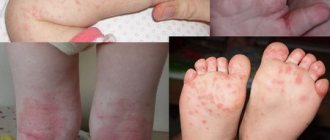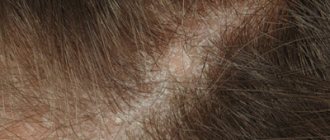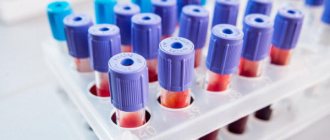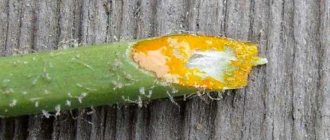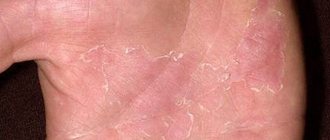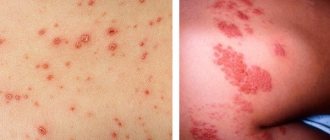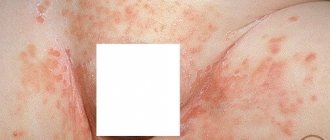Allergic reactions on the skin occur under the influence of certain substances in people with hypersensitive skin.
Related articles:
Photos of contact dermatitis: symptoms and treatment Photos of perioral dermatitis: symptoms, causes and treatment Causes and symptoms of exfoliative dermatitis, treatment Treatment of dermatitis with ointments and creams Photos of atopic dermatitis in adults: diagnosis and treatment
The mechanism of manifestation of dermatic allergies is as follows:
- First, certain substances come into contact with the skin;
- Antibodies are formed on the skin;
- the human immune system becomes sensitive to this allergen;
- the skin becomes blistered and red.
The place of traditional treatment in the complex therapy of dermatitis
Treatment of dermatitis at home is carried out only after consultation with a doctor. Atopic dermatitis and other types of this disease are treated comprehensively. To treat allergic dermatitis, you will need to avoid contact with products that caused a negative reaction. Additionally, you will need to adhere to a diet throughout treatment. The doctor prescribes antihistamines, anti-inflammatory ointments, and enterosorbents if necessary.
Using folk remedies, you can eliminate some of the symptoms of the disease (itching, rash, redness of the skin), but you will not be able to recover completely.
Tar soap for healthy skin
This wonderful folk remedy successfully fights dermatitis of any etiology, but has a characteristic odor. Tar soap has all the beneficial properties that birch tar has.
When treating areas affected by dermatitis with soap, the peculiar odor disappears in 10–15 minutes, and the improvement of blood supply, regeneration of damaged skin and the anti-inflammatory effect remain in effect for a long time.
Important! Do not use liquid tar soap for compresses and lotions, as it contains sodium lauryl sulfate, a surfactant that is undesirable for use in dermatitis.
Birch tar
Baths, lotions, and compresses are made with tar soap at home. To do this, foam the bar in 100 g of warm water, moisten a piece of soft cloth, squeeze it lightly and apply it to the wounds. Tar can cause an allergic reaction, so test the dermis before the procedure.
For atopic dermatitis, after using tar soap, apply any emollient, preferably for children, cream.
If you have been diagnosed with allergic dermatitis, use water baths with a light concentration of pure birch tar solution.
Therapeutic baths
Herbal baths are proven folk remedies for dermatitis. Their use is relevant when large areas of the body are affected. For treatment, you can use baths with the addition of the following herbal ingredients:
- Calendula flowers, chamomile and sea buckthorn leaves. For a bath you will need to take 10 g of dry raw materials, pour a liter of boiling water and let it brew. Add the resulting broth to a bath of water.
- Oak bark and oatmeal. Mix the ingredients in equal proportions and add warm water so that 1 part of the mixture contains 5 parts of water. The solution should completely cover the body; it will take 10-20 minutes to remain in it. At the end of the bath, rinse your skin with warm water.
- Birch or pine buds. For traditional treatment you will need to take 400-500 g of raw materials. Next, pour five liters of boiling water over it and let it brew for at least 5-6 hours. It is best if the buds are infused in a thermos.
To prepare baths according to folk recipes, you can use other herbs with an anti-inflammatory effect: elecampane, mint, St. John's wort, sage, etc. They can be purchased at a pharmacy or prepared yourself.
Before treating the disease at home, be sure to consult a specialist.
The advantage of traditional treatment is the low price of ingredients. The disadvantage is the need to prepare solutions in advance and wash the bath from them after the procedure.
Due to the complexity of preparation, medicinal baths are used only when dermatitis is widespread.
How to treat dermatitis?
Treatment of simple contact dermatitis consists of eliminating the effect of the irritating factor and neutralizing it (for example, in case of dermatitis from chemicals, the affected area is treated with running water). Local therapy is carried out taking into account the severity of inflammatory phenomena. Powders, disinfectant lotions, combined corticosteroid aerosols, creams, ointments, and photoprotective agents (for solar dermatitis) are used. For significant swelling of the face and genitals, diuretics and local cold lotions are indicated. In cases of disseminated lesions, especially with the presence of multiple bullous elements and a violation of the general condition, systemic glucocorticosteroid therapy is indicated.
If there are bubbles, they are opened and processed.
For chronic dermatitis, warm baths and emollient ointments, corticosteroids, and then keratoplasty ointments are used. Treatment of extensive burns and frostbite is carried out in specialized departments.
Treatment of allergic contact dermatitis involves eliminating the effects of sensitizing substances. In case of severe clinical manifestations, a diet is prescribed with a restriction of salt, carbohydrates and extractives. General treatment consists of prescribing hyposensitizing agents, enterosorbents, diuretics, vitamins (ascorbic acid), calcium pantothenate, calcium pangamate, potassium orotate, and in severe cases, corticosteroids and neohemodesis.
Local treatment is carried out taking into account the stage of the disease and the severity of the inflammatory process. Powders, lotions, water and oil mash, indifferent pastes (zinc with the addition of 1-2% dermatol), absorbable ointments (2% sulfur-salicylic, 2% sulfur-tar, 1-2% ichthyol), corticosteroid creams, ointments, aerosols.
Herbal compresses
These folk remedies for dermatitis are effective when the area of the rash is not large enough to be treated with baths.
Compresses for dermatitis are prepared according to certain rules. To apply them, use linen or cotton fabric, as well as ordinary gauze, folded several times. The bandage soaked in the solution will need to be kept on for about half an hour.
For compresses against dermatitis according to folk recipes, the following are used:
- Brewed medicinal herbs that promote healing of wounds and inflammation. Such herbs include St. John's wort, sage, fireweed, coltsfoot, chamomile, string, yarrow, elecampane. A tablespoon of dry crushed herb is poured into a glass of boiling water, left for an hour, and then lotions are made.
- Tincture of celery juice and apple cider vinegar. They are mixed in equal quantities, and a pinch of salt is added to the resulting composition if desired. The prepared mash is not suitable for long-term storage. Before each use, you will need to prepare a new portion of the medicine.
- Pumpkin pulp, raw potatoes. These food products are crushed into a paste and applied to sore spots.
The advantage of compresses is that they can be used to treat any form of dermatitis, not only in adults, but also in children. Preparing a medicinal solution according to a folk recipe takes a few minutes, and the ingredients for it can be found at the nearest pharmacy or kitchen.
Treatment with folk remedies in adults
In addition to traditional treatment methods, folk remedies are used to combat the disease in adults. The basis for medicines can be medicinal plants, bee products or oils. It is not recommended to use folk remedies in the following cases:
- hypersensitivity to components;
- severe renal and liver dysfunction;
- period of pregnancy and lactation.
If the appearance of a rash is accompanied by high fever, general weakness, dizziness or cough, you should consult a doctor.
Compresses and lotions
The following remedies will help cope with the manifestations of allergic dermatitis:
- fresh celandine grass is crushed and the juice is squeezed out using gauze. It is diluted half and half with water and stored in a tightly closed glass container in the refrigerator. Used as lotions. To do this, soak a piece of gauze in the juice and apply it to the affected area for 15 minutes. You should not extend the exposure time, since celandine-based products are potent and, if used incorrectly, the course of the disease will worsen. For long-term storage of celandine juice, add 30 ml of 70% alcohol per 100 ml of product to the solution. In this case, the lotions are applied for 10 minutes;
- 2 g of dry celandine herb is poured into 250 ml of boiling water and left for 40 minutes. Soak a cotton swab in the infusion and apply to damaged skin for 20 minutes. The procedure is carried out once a day for a week. The finished infusion is stored for no more than 3 days in the refrigerator. If you are not allergic to bee products, you can add honey to the product, it will speed up healing and improve skin regeneration;
- 2 g of dry boric acid powder are dissolved in 100 ml of boiled cooled water. At the next stage, add 10 g of birch tar to the solution and mix thoroughly. The product is used in the form of compresses, which are applied to the affected area for 15-20 minutes. The procedure is carried out morning and evening throughout the week;
- mix 2 g of oak bark, calendula flowers and creeping budra stems. The raw materials are poured with a liter of water and boiled for 3 minutes. Strain and use in the form of lotions and compresses;
- 50 g of elecampane roots are poured into 300 ml of boiling water and left for 2 hours. Strain, soak a gauze cloth in the infusion and apply it to the affected area for half an hour;
- A liter jar of dry wheatgrass roots is filled with 10 liters of water and left for 6 hours. Then the product is put on fire and boiled for half an hour. After it has cooled slightly, filter and pour into the bath. You need to bathe in this decoction for 20 minutes. The procedure is repeated daily for a week.
Ointments
In the complex treatment of allergic contact dermatitis, ointments prepared at home are used:
- Dandelion roots are thoroughly washed and dried. Using a coffee grinder, they are turned into powder, which is mixed in equal proportions with May honey. The ointment is applied to the affected area and left for an hour, then washed off with warm whey. The product is used morning and evening for 2-3 weeks;
- a glass of linseed oil is heated in a water bath, 20 g of beeswax and 1 g of propolis are added. The yolk of a pre-boiled fresh chicken egg is crushed and dipped in small portions into a boiling solution (it can foam a lot). Then the product is removed from the heat and filtered while hot, using nylon cloth for this purpose. The finished ointment is stored in a glass jar on the bottom shelf of the refrigerator. It is applied to the rash area 2-3 times a day and left until completely absorbed. It is used until the disease subsides. This ointment can be used for wounds, abrasions, and irritations. It is stored for a year;
- 100 g of olive oil and butter are placed in a clay pot, 2 tablespoons of chopped aloe leaves and onions are added and the lid is tightly closed. Simmer in the oven for an hour. Apply to the skin twice a day until the condition improves;
- Dissolve 100 g of butter over low heat, add 50 g of rosin, beeswax and laundry soap. After the ointment acquires a uniform structure, it is placed in a glass jar and stored in a cool, dark place. Apply to the rash 2-4 times a day, depending on the degree of damage. Use the product for a month.
Baths
Baths for allergic dermatitis can reduce itching, moisturize the skin and reduce the manifestations of the disease. They are done daily for 2 weeks. The finished product can be reused 2-3 times. In complex therapy of the disease, the following infusions are used:
- to 1 kg of wheat bran add 20 g of calamus roots, 50 g each of string grass, oak bark and white willow bark. All this is poured with 12 liters of boiling water, after cooling to a comfortable temperature, the product is filtered and 300 g of kitchen salt is added. Take this bath for 15 minutes. If the disease affects small areas of the skin, this decoction can be used for baths or compresses;
- 0.5 kg of oat bran is poured into 10 liters of boiling water and left for an hour. Strain and use for bathing for allergic dermatitis.
After the procedure, you should not wipe the skin; you need to wait until it dries on its own and, if necessary, apply a medicinal ointment or cream.
Oral preparations
The following agents are used for oral use for allergic dermatitis:
- mix 50 g of string grass, chamomile and calendula flowers. Pour 200 ml of boiling water over a teaspoon of the product and leave for half an hour. Strain and add honey to taste. Take the product 3 times a day for 3 weeks. The collection has an anti-inflammatory effect and relieves itching well;
- Mix a glass of viburnum and sea buckthorn berries, grind them in a blender and add 400 g of honey. The product is left in the refrigerator for a week, then mixed and a glass of cognac is added. Take it one tablespoon in the morning and evening. This mixture will help normalize the functioning of the immune system.
Tinctures against dermatitis
To prepare tinctures, 70% medical alcohol or good quality vodka is used. Prepared medications are stored in dark glass containers with a tight-fitting lid. Folk remedies are used to treat allergic dermatitis in adults:
- mix 2 g of nettle leaves, birch buds, calendula flowers, add 100 ml of vodka, leave for 10 days. Strain and consume 20 drops three times a day;
- 2 g each of motherwort, bearberry, hawthorn flowers, birch buds. The collection is poured with alcohol and left for a week. Use before meals 4 times a day, 15 drops. Treatment is continued for 2 months.
Antidiathesis decoction
This remedy is used to treat atopic dermatitis in children over 2 years of age. The following components are used for its preparation:
- 5 g of string grass;
- 5 g tricolor violet;
- 1.5 g blackcurrant leaves.
The collection is poured with a liter of water and left for 2 hours, after which it is placed on low heat and boiled for 5 minutes. After the broth has cooled, it is filtered and stored in the refrigerator for no more than 3 days. Take before meals, 3 times a day for 2 weeks:
- children from 2 to 5 years old – 5 ml;
- from 5 to 12 years – 10 ml;
- adults – 20 ml.
It is not recommended to give the decoction to children under 2 years of age and people with hypersensitivity to the components.
Bay leaf infusion
Laurel leaves contain essential oils, trace elements, and B vitamins. The infusion is used to treat diseases in both children and adults. To prepare it, pour 3 medium-sized sheets with a glass of boiling water and leave until completely cool. Children under 5 years of age are given a teaspoon of the product 2-3 times a day.
To eliminate the symptoms of the disease, adults are recommended to take 100 ml of decoction in the morning and evening. Children from 5 to 12 years old are given 40 ml 2-3 times a day. Treatment is continued for 2 weeks.
Alcohol tincture of birch buds
Birch buds contain volatile oils, saponins, tannins, betulorethic acid, and saponins. To prepare the tincture, pour 300 ml of alcohol into half a glass of raw material and leave for 14 days in a dark place. The tincture is filtered, filtered and taken 20 drops, after dissolving in a tablespoon of water. Treatment is continued for 14 days, then a week's break is taken and, if necessary, therapy is resumed.
Dandelion decoction
Dandelions contain bitterness, organic acids, asparagine, riboflavin, calcium and potassium salts, and saponins. For allergic dermatitis, the following remedies are used:
- A tablespoon of flowers is poured into 250 ml of boiling water and placed on low heat for 2 minutes. After cooling, filter and drink in small sips. Take morning and evening throughout the week. You can add honey to tea;
- 2 g of dandelion roots are poured into a glass of water and simmered over low heat for 1 minute. After cooling, filter and consume internally. You need to take the decoction 2-3 times a day for 2 weeks;
- mix 2 tbsp. spoons of dandelion leaves, stinging nettle and blackthorn flowers, pour 500 ml of water, boil for 1 minute and leave for an hour. Strain and take 100 ml 4 times a day for 2 weeks.
Blackcurrant brew
Blackcurrant leaves contain phytoncides, which help combat skin allergies. Infusions based on this plant are used for both internal and external use. To prepare the tea leaves, mix a tablespoon of black currant berries and the same amount of leaves, brew with a liter of boiling water and leave for 4 hours. Strain and take 150 ml 3 times a day.
For bathing, currant branches along with leaves are poured with boiling water and after half an hour added, without filtering, to the bathing water. Treatment with black currant continues for 21 days.
Topical lotion
To wipe the skin with allergic dermatitis, use a lotion that can be prepared at home. It has anti-inflammatory and antiseptic effects.
You will need 3 tablespoons of pulp of aloe leaves and fresh cucumber. They are placed in a glass jar, filled with 150 ml of vodka and left for a week. Then the product is filtered and diluted with the same amount of boiled chilled water. Store the prepared lotion in the refrigerator and use it to cleanse the skin in the morning and evening. Since the lotion contains alcohol, a nourishing cream is applied after its use.
Oak bark baths
Oak bark contains tannins and has a pronounced anti-inflammatory and antifungal effect. To treat dermatological diseases, 50 g of dry raw materials are poured with a liter of boiling water and left for 2 hours. The product is filtered, and the finished infusion is poured into a bath of warm water. Take it daily until the skin clears.
Anti-itch ointment
To eliminate itching, prepare an ointment at home. 100 g of pork fat is melted in a water bath, 10 g of beeswax is added, then removed from the heat and mixed with 100 ml of birch tar and 50 ml of string infusion. The ointment is applied to the area of the rash 2-3 times a day;
Treatment with propolis oil
Propolis oil has anti-inflammatory, antifungal, antiviral effects, improves metabolism and accelerates skin regeneration. To prepare it, 20 g of propolis are pre-frozen and then thoroughly crushed. 100 ml of olive oil is heated in a water bath to 80 degrees (do not boil). Then add propolis and mix until completely dissolved. Apply to the area of the rash 3-4 times a day until the symptoms of the disease disappear.
Pumpkin tampons
Pumpkin tampons will help improve the condition of the skin in case of allergic dermatitis, speed up regeneration and eliminate itching. This remedy is effective if the rash affects small areas of the skin. The pumpkin is crushed and the juice is squeezed out, which is used to soak cotton swabs. They are applied to the damaged area and secured with a bandage. Leave them until dry. The procedure is carried out daily for a month.
Treatment with St. John's wort
St. John's wort contains tannins, volatile oil, resinous substances, phytoncides and antibiotics. To combat rashes, little St. John's wort is used. To prepare it, pour sunflower oil into a glass jar, add a glass of plant flowers, close the lid and expose it to the sun for 2 weeks. Then add the same amount of raw material and leave until the oil turns dark red. The product is filtered and applied to the skin 2-3 times a day. Treatment is continued for at least 2 weeks.
Pear lotions
To reduce itching, moisturize the skin and get rid of rashes, use pear lotions. To do this, plant branches are brewed with boiling water and left for 2 hours. After which, a piece of cotton fabric is soaked in the infusion and applied to the affected area. The lotion is fixed and left overnight. Treatment is carried out for 2 weeks.
Using a sequence
The most effective folk remedies for allergic dermatitis include string grass. The plant contains tannins, alkaloids, carotene, and essential oils. Decoctions and infusions of the string relieve itching, eliminate rashes, and reduce inflammation. For allergic dermatitis, the following medications are used:
- decoction of string. 3 g of crushed raw material is poured into 250 water, boiled over low heat for 2 minutes. After cooling, filter and take 100 ml 4 times a day. To improve the skin condition, take this decoction for 2-3 weeks;
- infusion of succession. 5 g of string is poured into 500 ml of boiling water and left under the lid overnight. In the morning, strain, add honey to taste and take 150 ml three times a day before meals. Treatment is continued for a month;
- compress. Fresh leaves of the plant are mashed until the juice appears. Apply to the affected area, cover the top with film and leave for 2-3 hours. The procedure is carried out once a day.
Starch in the fight against atopic dermatitis
Corn or potato starch is used to soften the skin and eliminate itching in atopic dermatitis. Dissolve 100 g of the product in bathing water and take a bath for 20 minutes. This procedure can be carried out daily.
In case of severe itching, starch is diluted with a small amount of water, turning it into a paste, and applied to the damaged area. After half an hour, wash off and use medicinal ointment.
Compresses and celery juice
Celery juice is very rich in vitamins; if used regularly, it will help not only get rid of the manifestations of the disease, but also improve the condition of the skin in general. Every day you need to drink a glass of this remedy in the morning and evening. Prepare it immediately before use.
For compresses, celery is crushed, wrapped in one layer of gauze and applied to areas where there is a rash. The compress should be secured and left overnight. This procedure is carried out daily for 10 days.
Homemade ointments
Folk ointments for the treatment of dermatitis are prepared from two components:
- The basis. Its role can be played by Vaseline, olive oil, glycerin, baby cream or bee honey. Thanks to these components, the finished product can be spread on the skin. The most beneficial are olive oil and bee honey, as they contain many nutrients that speed up the restoration of the skin.
- Active ingredient. These are juices and decoctions of medicinal herbs with an anti-inflammatory and exfoliating effect. Most often, people use the juice of cranberry, Kalanchoe, aloe, and golden mustache. You can also use decoctions of St. John's wort, licorice, and celandine.
It is necessary to mix the components and let the resulting ointment brew for a couple of hours. The affected areas are treated before bedtime, and the mixture is washed off in the morning. For treatment to be effective, the skin must be washed to remove dirt and sweat before applying the ointment.
Don’t forget to eat right and exclude possible allergens from the menu.
Examples of self-prepared ointments:
- Mix 100 g of Vaseline with the same amount of cranberry juice. Apply the resulting mixture in a thin layer to the affected skin and cover with a gauze bandage.
- 40 ml of distilled water is diluted with 30 g of a 2% solution of novocaine or lidocaine. 30 g of zinc ointment is added to the mixture, and dermatitis is treated with the resulting mass.
The advantage of folk ointment is that it can be applied for a long time. In addition, the ointment can be prepared for several days and stored in the refrigerator. The disadvantage of folk creams for dermatitis is that they can stain clothes and bedding, because during sleep you can accidentally remove the bandage.
It is recommended to take this feature into account and, during treatment procedures, use bedding that you don’t mind throwing away.
Vegetable oils
Traditional methods for treating dermatitis include treating the skin with vegetable oils. There are two types:
- Ready-made oils purchased at the pharmacy. You can treat rashes using rose, tea and ricin oils. These folk remedies soothe itching and accelerate the healing of inflamed areas.
- Homemade oils. The base for them is butter or olive oil. Other ingredients are added to the base - rosehip seeds, crushed St. John's wort flowers, celandine powder.
The most difficult thing to prepare is tar oil. You will need to melt 100 g of baby soap, add 40 g of oil and tar, as well as 100 ml of water.
You can prepare your own oil from the following proportions:
- 100 g of sea buckthorn oil and 2 tablespoons of sulfur.
- 2 parts of any vegetable oil and 1 part of propolis.
- 80 g of animal fat and a tablespoon of sea buckthorn.
Homemade and store-bought oils for dermatitis will need to be applied 5 times a day and left until absorbed.
Among the undeniable advantages of oils are high efficiency and ease of use. Some products do not need to be prepared yourself; you can simply buy them at the pharmacy.
The disadvantages of oils include the ability to stain clothes. Because of this, patients use oils if they do not need to leave the house during the day.
Dermatitis causes
- may appear after treatment with iodine, streptocide
- Novocaine may be the cause if there is hypersensitivity
- dermatitis occurs at the site of mechanical impact - abrasion
- Irritants that cause disease include burns, frostbite
- Often the cause of dermatitis is the sun's rays
- dermatitis appears at the site of electric shock
- may appear after a flea or bedbug bite
- Plants may be the cause of the inflammatory disease
Decoctions and tinctures for oral administration
Herbs can be used internally. This treatment is less effective than external use, but helps strengthen the immune system and increase resistance to the inflammatory process.
You can prepare medicines from chamomile flowers, string leaves, yarrow, nettle, lemon balm, sage, mint. There are two options for such treatment at home using folk remedies:
- Decoction. It is necessary to pour 1 tbsp. selected dry herb with a glass of boiling water and let it brew for an hour. Take half a glass of decoction 3 times a day.
- Alcohol tincture. To do this, you will need to pour the raw material not with water, but with vodka, and let the mixture brew for 3-7 days. Use the resulting product 1 tbsp. in the morning and in the evening.
Decoctions of medicinal herbs and tinctures from them are an effective remedy, but only if the patient does not have individual contraindications. Therefore, it is best to familiarize yourself with the list of possible side effects and diseases for which the use of a decoction or tincture is prohibited before purchasing this or that herb.
Other means
Tar is effective for treating dermatitis. This remedy is effective, but it has a serious drawback - an unpleasant odor. It is better not to use tar in its pure form. The ideal solution would be to use tar soap during the shower. The tar in its composition will dry the affected skin and relieve itching.
You can use herbal soaps and shampoos. Switching to natural products will minimize the likelihood of an allergic reaction and will help restore the skin faster.
Traditional medicine offers many ways to treat dermatitis, but they only eliminate the symptoms of the disease. To get rid of the cause of the rash, you will need to turn to traditional medicine. For treatment with traditional methods to be effective, it is necessary to start it only after the start of the main treatment. If you have allergic reactions, you will need to consult your doctor about the possibility of using specific products.
Causes and symptoms of the disease
The process is based on the protective reaction of the immune system to external stimuli. Despite the fact that the allergen comes into contact with a small area of skin, the sensitivity of the entire body increases. In this case, mast cells begin to release histamine (a neurotransmitter of immediate allergic reactions), which acts on H1 receptors. As a result, an inflammatory process develops.
Manifestations of allergies can occur during contact with chemicals, plants, and medications for external use. Factors influencing the development of the disease:
- disruption of the sebaceous glands;
- fungal infections;
- frequent stress;
- frequent contact with chemical irritants;
- bacterial infection;
- genetic predisposition.
The development of the disease is indicated by the appearance of symptoms such as itching, burning, redness of the skin, a feeling of heat at the site of inflammation, and swelling. In the future, a small rash or blisters filled with liquid may appear on the skin. In some cases, the disease is accompanied by fever, weakness and headache.
